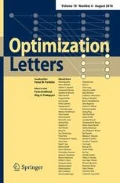Abstract
Quadratic convex reformulation is an important method for improving the performance of a branch-and-bound based binary quadratic programming solver. In this paper, we study a new convex reformulation method. By this reformulation, the efficiency of a branch-and-bound algorithm can be improved significantly. We also compare this new reformulation method with other proposed methods, whose effectiveness has been proven. Numerical experimental results show that our reformulation method performs better than the compared methods for certain types of binary quadratic programming problems.

Similar content being viewed by others
References
Anjos, M.F., Chang, X.-W., Ku, W.-Y.: Lattice preconditioning for the real relaxation branch-and-bound approach for integer least squares problems. J. Global Optim. (2014)
Anstreicher, K.M.: Semidefinite programming versus the reformulation-linearization technique for nonconvex quadratically constrained quadratic programming. J. Global Optim. 43, 471–484 (2009)
Billionnet, A., Elloumi, S.: Using a mixed integer quadratic programming solver for the unconstrained quadratic 0–1 Problem. Math. Program. 109, 55–68 (2007)
Burer, S.: On the copositive representation of binary and continuous nonconvex quadratic programs. Math. Program. 120, 479–495 (2009)
Garey, M.R., Johnson, D.S.: Computers and intractability: a guide to the theory of NP-completeness. Freeman W.H., Madison (1979)
Goemans, M.X., Williamson, D.P.: Improved approximation algorithms for maximum cut and satisfiability problems using semidefinite programming. J. ACM 42, 1115–1145 (1995)
Halikias, G.D., Jaimoukha, I.M., Malik, U., Gungah, S.K.: New bounds on the unconstrained quadratic integer problem. J. Global Optim. 39, 543–554 (2007)
Lemarechal, C, Oustry, F.: SDP relaxations in combinatorial optimization from a Lagrangian point of view. In: Hadjisavvas, N., Pardalos, P. (eds) Proceedings of Advances in Convex Analysis and Global Optimization, pp. 119–134. Kluwer Academic Press, New York (2001)
Lu, C., Wang, Z., Xing, W.: An improved lower bound and approximation algorithm for binary constrained quadratic programming problem. J. Global Optim. 48, 497–508 (2010)
Malik, U., Jaimoukha, I.M., Halikias, G.D., Gungah, S.K.: On the gap between the quadratic integer programming problem and its semidefinite relaxation. Math. Program. 107, 505–515 (2006)
Ma, W.-K., Davidson, T.N., Wong, K.M., Luo, Z.-Q., Cing, P.-C.: Quasi-maximum-likelihood multiuser detection using semi-definite relaxation with application to synchronous CDMA. IEEE Trans. Signal Process. 50, 912–922 (2002)
Ma, W.-K., Su, C.-C., Jaldén, J., Chang, T.-H., Chi, C.-Y.: The equivalence of semidefinite relaxation MIMO detectors for higher-order QAM. IEEE J. Sel. Topics Signal Process. 3, 1038–1052 (2009)
Pardalos, P.M., Rodgers, G.P.: Computational aspects of a branch and bound algorithm for quadratic zero-one programming. Computing 45, 131–144 (1990)
Poljak, S., Wolkowicz, H.: Convex relaxations of (01)-quadratic programming. Math. Oper. Res. 20, 550–561 (1995)
Sidiropoulos, N.D., Luo, Z.-Q.: A semidefinite relaxation approach to MIMO detection for higher-order QAM constellations. IEEE Signal Process. Lett. 13, 525–528 (2006)
Sun, X.L., Liu, C.L., Li, D., Gao, J.J.: On duality gap in binary quadratic programming. J. Global Optim. 53, 255–269 (2012)
Tan, P., Rasmussen, L.: The application of semidefinite programming for detection in CDMA. IEEE J. Sel. Areas Commun. 19, 1142–1449 (2001)
Vandenberghe, L., Boyd, S.: Semidefinite programming. SIAM Rev. 38, 49–95 (1996)
Wolsey, L.A.: Integer programming. Wiley, New York (1998)
Author information
Authors and Affiliations
Corresponding author
Rights and permissions
About this article
Cite this article
Lu, C., Guo, X. Convex reformulation for binary quadratic programming problems via average objective value maximization. Optim Lett 9, 523–535 (2015). https://doi.org/10.1007/s11590-014-0768-0
Received:
Accepted:
Published:
Issue Date:
DOI: https://doi.org/10.1007/s11590-014-0768-0




